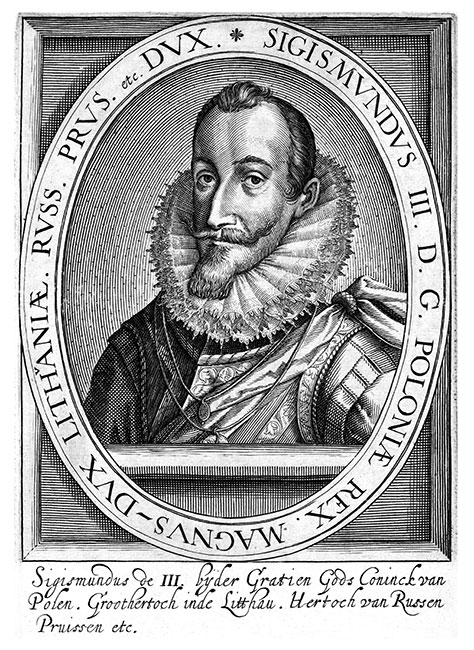Sigismund III, King of Poland
|
 Sigismund III, King of Poland and Grand Duke of Lithuania Engraving by Nicolas de Clerck |
Sigismund III, by the grace of God, King of Poland, What Wikipedia says about it : Sigismund III Vasa (Polish: Zygmunt III Waza, Lithuanian: Žygimantas Vaza; 20 June 1566 – 30 April 1632 N.S.) was King of Poland and Grand Duke of Lithuania from 1587 to 1632 and, as Sigismund, King of Sweden from 1592 to 1599. He was the first Polish sovereign from the House of Vasa. Religiously zealous, he imposed Catholicism across the vast realm, and his crusades against neighbouring states marked Poland's largest territorial expansion. As an enlightened despot, he presided over an era of prosperity and achievement, further distinguished by the transfer of the country's capital from Kraków to Warsaw. Continued on Wikipedia Engraving from a collection of 88 engravings |
Text below taken from Louis Moreri's Grand Dictionnaire Historique - 1725 SIGISMUND III, son of John III, King of Sweden, and Catherine, daughter of Sigismund I, King of Poland, born in 1566, received the sceptre of Poland on 9 August 1587 and was crowned to the exclusion of Maximilian of Austria, who had been elected by a few lords. He established himself perfectly in this kingdom; and after his father's death, he went to take possession of Sweden, where he was installed on 19 February 1594. This king was a zealous Catholic, which did not please the Swedes, almost all of whom were already committed to the errors of the Protestants. Charles, Prince of Sudermania, the king's uncle, took advantage of this situation and, skilfully encouraging the rumblings of the rebels, had the crown placed on his head. This usurpation was the seed of a very long war, in which Sigismund was not successful. He had great disputes with the Tartars and Muscovites, whom he drove out of Smolensk in 1611 after a two-year siege, and died in 1632 after a reign of 45 years. This prince had married Anne and Constance of Austria, who were sisters and daughters of Ferdinand II, Emperor of the same name. From the first he had Ladislas-Sigismund; and from the second John Casimir, both kings, both husbands of the same woman, Marie de Gonzague de Nevers.
Text below taken from Universal Biography of Men Who Made a Name for Themselves by F.X. Feller – 1860 – Personal collection SIGISMUND III .../... . Piety, justice and clemency were the hallmarks of this prince's character. He lost the crown of Sweden by declaring himself in favour of the interests of the Catholic religion. It was this same zeal that deprived him of the Muscovite Empire. He loved truth too much to sacrifice it to any interest whatsoever; the slightest dissimulation seemed to him a kind of apostasy. His eldest son succeeded him under the name of Wladislas VII or Ladislas.
Automatic translations from French to Polish by DEEPL |
![]()
Copyright registration against any commercial use
of photographs, texts and/or reproductions published on this site
See explanations on "Home" page
| Site Map | Research | Links |